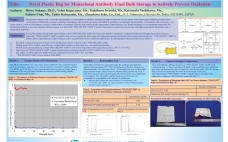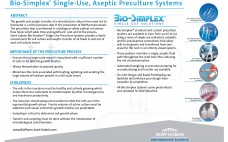During the past decade, single-use bioreactors have become widely accepted for use in cell culture process development and clinical manufacturing. Their key benefits over stainless steel bioreactors are flexibility, cost, and time savings associated with the reduction of cross-contamination risks (1). Here, we describe our approach to development and qualification of the Biostat STR single-use, stirred-tank bioreactor. Unlike other stirred single-use bioreactors, it offers a similar design to that of well-established, conventional (stainless steel) stirred-tank bioreactors. Disposability of the single-use…
Expression Platforms
PEGylation of Biologics
In the 1970s, life-science researchers envisioned protein therapeutics as the ultimate targeted therapy. Companies could use them to address genetic deficiencies and cancer, among other disease classes, as well as to nudge the immune system for treating autoimmune disorders. The first therapeutic proteins were derived from animal or microbial cells, so patients launched immune responses to them that could curtail their activity and produce dangerous side effects. PEGylation was initially used to prevent immune responses with such drugs. PEG is…
Implementation of Quality By Design in Vaccine Development
At the IBC Third Annual International Forum on Vaccine Production, I presented an outline of “Best Practices for Quality by Design (QbD) in Biological Products and How to Implement in Vaccines.” It covered process development and QbD principles, best practices used in biologics, how QbD fits in with process validation, how it applies to vaccines, and some thoughts on the potential for seasonal vaccines. Shifts in Process Development Classic process development (as practiced in the early days) generally involved rudimentary…
Protein Scaffolds
The recent success of monoclonal antibodies (MAbs) as therapeutic agents to treat cancer, multiple sclerosis, rheumatoid arthritis, and other chronic inflammatory and autoimmune disorders (Table 1) has catapulted these once difficult-to-develop molecules to the forefront of modern molecular medicine (1, 2). The size of the global MAb market in 2008 was valued at almost US$28 billion. Industry analysts predict that the size of the MAb market will grow to almost $68 billion by 2015, with the largest growth occurring in…
A High-Yielding, CHO-K1–Based Transient Transfection System
Biotherapeutics have emerged as effective treatments for many diseases. It’s estimated that every year hundreds of new biotherapeutic candidates enter development (1). Stable transfection of host cells to establish high-producing cell lines is the approved method for generating clinical-grade recombinant biologics. However, biotechnology companies needing to speed up their developmental timelines are increasingly relying on material generated using transient transfection (1, 2). Unlike stable gene expression (SGE) that requires several months of laboratory and process work, transient gene expression (TGE)…
Screening Yeastolate Raw Material Used in Insect Cell Culture Media
Insect cell culture is widely used as an industrial platform in recombinant protein production for research and diagnostics (1, 3,4,5). Many commercial yeastolate products are intended as nutritional supplements for not only insect cell culture, but also for mammalian cell culture and bacterial fermentation applications (6,7,8,9,10,11,12,13,14,15). Yeastolate plays an important role in modern biological production because it can be very effective in promoting insect cell growth and enhancing production of recombinant proteins. The product is known to contain amino acids,…
Improving Cell Culture Productivity with a SEGFLOW® Automated On-line Sampling and Feed System
A SEGFLOW® automated on-line sampling and feed system (SEGFLOW) was evaluated for its impact on Chinese Hamster Ovary (CHO) cell culture process performance in bench-scale stirred tank bioreactors. The SEGFLOW was integrated with a YSI® Biochemistry Analyzer and a nutrient feed pump allowing real-time glucose analysis and automated glucose feeding to be performed for the test batch. In contrast, a batch using daily manual sampling and bolus feed protocols, was performed as a control. For the SEGFLOW culture, media glucose…
Novel Plastic Bag for Monoclonal Antibody Final Bulk Storage to Actively Prevent Oxidation
Essentially, human protein such as monoclonal antibody is quite susceptible against oxidation. Nevertheless using the oxygen barrier containers, oxygen within the protein solution and oxygen leaking through the closure port of container affect to the protein. To minimize oxidation of monoclonal antibody, novel plastic bag for monoclonal antibody final bulk storage has been developed. The concept “Active” means that removing oxygen not only passively from the circumstances through the barrier layer within the container (or bag), but also actively removing…
Characterization of a Biomanufacturing Fermentation Process Using a New DOE Approach: Definitive Screening Designs
Traditionally, a bioprocess is characterized using a two-step approach involving factor screening designs followed by response surface designs. This approach is very costly and time consuming since it requires a significant number of runs. Recently, Jones and Nachtscheim (2011) described a more efficient design that allows for factor screening, resolution of two-way interactions as well as estimation of quadratic effects in a single-step. The design, termed Definitive Screening has not yet been validated on a bioprocess. Here, traditional and Definitive…
Bio-Simplex™ Single-Use, Aseptic PreCulture Systems
The growth and aseptic transfer of a microbial pre-culture from seed vial to bioreactor is a critical process step in the production of BioPharmaceuticals. The pre-culture step is performed in a biological safety cabinet or laminar flow hood, which adds time and significant cost and to the process. Saint-Gobain Bio-Simplexâ„¢ Single-Use Pre-culture Systems provide a sterile environment for cell culture and aseptic transfer of all fluids in and out of each cell culture vessel.




